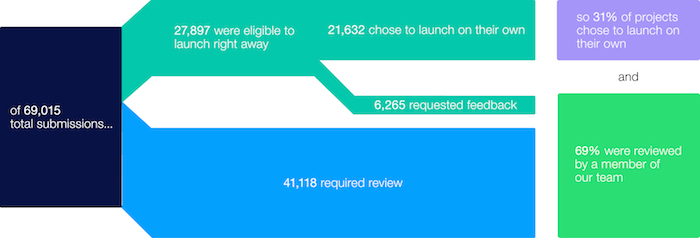Kickstarter has provided a look at how the reconfigured review system the put in place last year has worked out for them, providing some counterarguments to the opinion held in some corners of the Internet that Kickstarter has done away with a review system entirely, throwing open the gates to the wildlings of the north and other nefarious characters. In fact, Kickstarter says that the new process still results in the vast majority of projects submitted getting in front of human eyes, based on over six months’ worth of data.
The system uses an algorithm as a first line of automated review, which is designed to select for things that are mostly cookie-cutter and overwhelmingly likely to get the nod form a real person anyway, according to the site. That means that of 69,015 submissions made since the introduction of this system, 27,897 were cleared by the algorithm for direct activation, and a further 6,265 of those actually requested human feedback from Kickstarter before pressing the big green button, meaning only 31 percent of projects launched without human involvement post-approval process change.

That leaves 69 percent of projects benefiting from some kind of human intervention, and Kickstarter wants users to know that the human side is still a key part of what it’s offering. The blog post detailing the pool of stats from Yancey Strickler also talks about how the algorithm in use is continually being refined, and the purpose of it in the first place was to free up human reviewer time to give them more attention to offer help when and where it’s most needed.
A recent investigative report from Yahoo! Tech’s Dan Tynan found that Kickstarter was the most resistant to attempts to create fake funding campaigns aimed at potentially defrauding backers, and with this much human intervention it begins to make sense why. But that doesn’t change the fact that Kickstarter can often resemble a pre-order mechanism, despite the fact that it very clearly isn’t.
Crowdfunding doesn’t seem likely to be a fad that every fades away completely, which means that avoiding storefront-that-isn’t-a-storefront stigma may be the biggest barrier to more mainstream adoption. At the very least, making sure humans remain part of the equation seems like a good intermediary step to helping set expectations for this emerging category of online pseudo-commerce.
